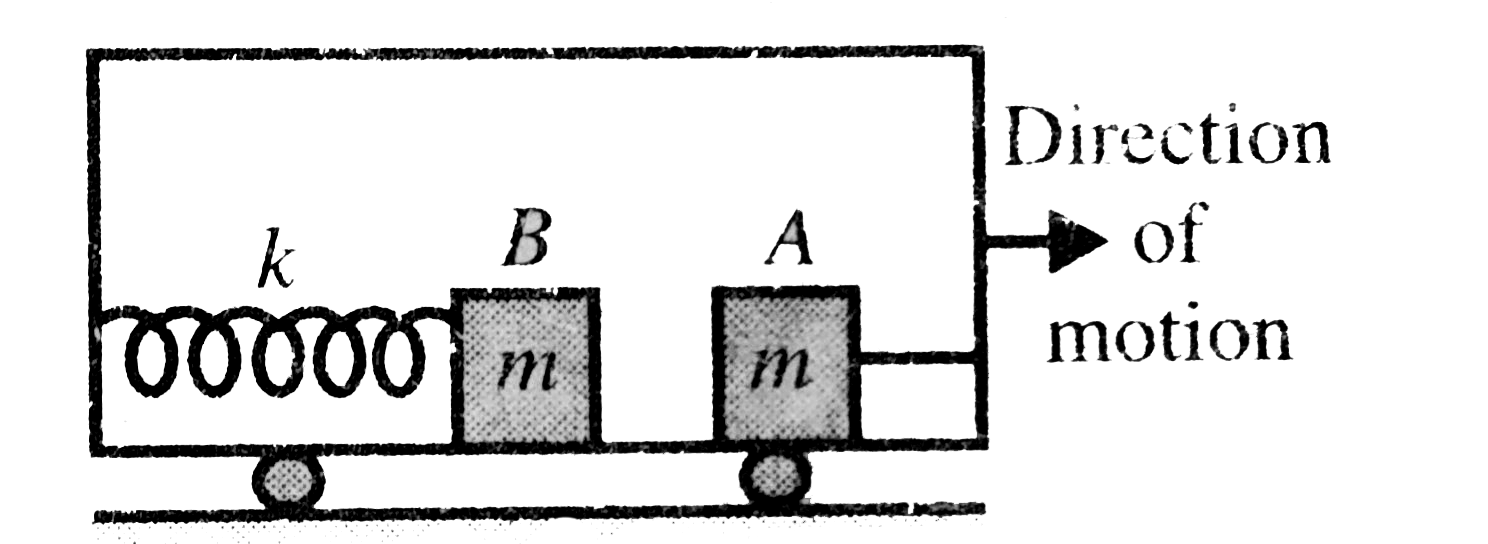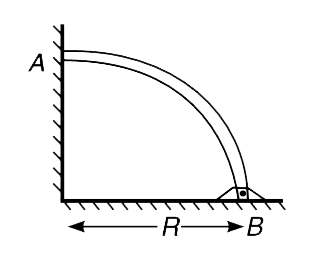
A ladder AB is spported by a smooth vertical wall ad rough horizontal floor as shown. A boy tarts moving from A to B slowly. The ladder remains at rest, then pick up the correct statements (s):
Magnitude of normal reaction by wall on ladder will increase
magnitude of normal reaction by wall on ladder will decrease
magnitude of normal reaction by floor on ladder will remain unchanged
magnitude of friction force by floor on ladder at will increase.
The correct Answer is:A, C, D
Let m and M be mass of man and ladder. From FBD normal reaction at A is N1=(m+M)g which remains constant net
Torwue on man + ladder is zero about B. if x decreases then torque of mg about B will decrease. Hence f must increase 
Topper's Solved these Questions
- BOOK - RESONANCECHAPTER - TEST PAPERSEXERCISE - PT-0130videos
TEST PAPERS
- BOOK - RESONANCECHAPTER - TEST PAPERSEXERCISE - Pt-0230videos
TEST PAPERS
- BOOK - RESONANCECHAPTER - TEST PAPERSEXERCISE - PART - II PHYSICS107videos
TEST PAPERS
- BOOK - RESONANCECHAPTER - SIMPLE HARMONIC MOTION EXERCISE - Advanced Level Problems13videos
SIMPLE HARMONIC MOTION
- BOOK - RESONANCECHAPTER - TEST SERIESEXERCISE - PHYSICS127videos
TEST SERIES
Similar Questions
A ladder 12 units long slides in a vertical plane with its ends in contact with a vertical wall and a horizontal floor along x-axis. The locus of a point on the ladder 4 units from its foot has the equation:
View SolutionA uniform ladder of length 3.25 m and weight 250 N is placed against a smooth vertical wall with its lower end 1.25 m from the wall. If coefficient of friction between the ladder and the floor is 0.3, then, find the frictional force acting on the ladder at the point of contact between ladder and floor.
View Solution
Knowledge Check
- Question 1 - Select One
A ladder of length 20 feet rests against a smooth vertical wall. The lowerend, which is on a smooth horizontal floor is moving away from the wall at the rate of 4 feet/sec. If the lower end is 12 feet away from the wall, then the rate at which the upper end move, is
A163 ft/secB−163 ft/secC3 ft/secD-3ftsec - Question 2 - Select One or More
A light stick of length l rests with its one end against the smooth wall and other end against the smooth horizontal floor as shown in the figure. The bug starts at rest from point B and moves such that the stick always remains at rest. aP is the magnitude of acceleration of but of mass m, which depends upon its distance of x from the top end of the stick. Choose the correct option (s)
 AaP=gsinθ(1−dl)BaP=gcosθ(1−xl)CThe time taken by the but to reach the bottom of the stick having started at the top end from rest is π2√lsinθ3gDThe time taken by the but to reach the bottom of the stick having started at the top end from rest is π2√lsinθ2
AaP=gsinθ(1−dl)BaP=gcosθ(1−xl)CThe time taken by the but to reach the bottom of the stick having started at the top end from rest is π2√lsinθ3gDThe time taken by the but to reach the bottom of the stick having started at the top end from rest is π2√lsinθ2 - Question 3 - Select One or More
Figure shows two identical blocks each of mass m kept on a smooth floor. Block A is connected to front wall with a just taut straight string and block B is connected to rear wall with a relaxed spring. Assume that the floor of the train car is smooth and exerts no horizontal forces on the blocks. Mark the correct statement(s).
 AWhen train moves with constant velocity there is no force either in string or spring.BImmediately after the train speeds up string gets taut and spring is compressed such that force exerted by each on respective blocks is same.CWhen train slows down block A moves towards front wall.DWhen train slows down resultant force on block A is non zero in ground frame.
AWhen train moves with constant velocity there is no force either in string or spring.BImmediately after the train speeds up string gets taut and spring is compressed such that force exerted by each on respective blocks is same.CWhen train slows down block A moves towards front wall.DWhen train slows down resultant force on block A is non zero in ground frame.
A small ball of mass 1kg is released from a smooth horizontal pipe containing a spring fixed at a height of 20m and 10m away from a vertical wall as shown in the figure. The initial compression of a spring is 2cm and it strikes a smooth vertical wall and smooth horizontal floor repeatedly and elastically as shown. The time period of one complete oscillation (g=10m/s2). (The ball do not collide with walls of the pipe ) is P+π50Q, the value of Q−P is__________
 View Solution
View SolutionA uniform quarter circular thin rod of mass M and radius R is pivoted at a point B on the floor. It can rotate freely in the vertical plane about B. It is supported by a smooth vertical wall at its other free end A so that it remains at rest. Find the reaction force of wall on the rod.
 View Solution
View SolutionA uniform ladder of mass 10 kg leans against a smooth vertical wall making an angle of 530 with it. The other end rests on a rough horizontal floor. Find the normal force and the frictional force that the floor exerts on the ladder
View SolutionA ladder 10 metres long rests with one end against a vertical wall, the other on the floor. The lower end moves away from the wall at the rate of 2 metres/minute. The rate at which the upper end falls when its base is 6 metres away from the wall
View SolutionA uniform ladder rests in limiting equilibrium, its lower end on a rough horizontal plae and its upper end against a smooth vertical wall. If θ is the engle of inclination of the ladder to the vertical wall and μ is the coefficient of friction then tanθ is equal to
View Solution

